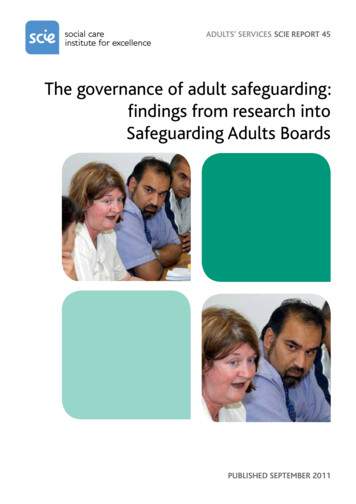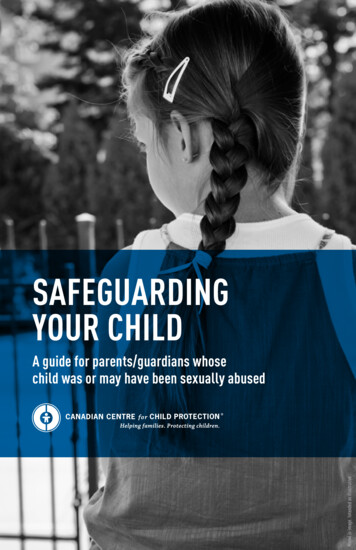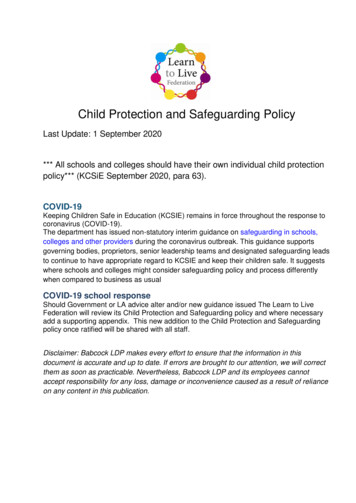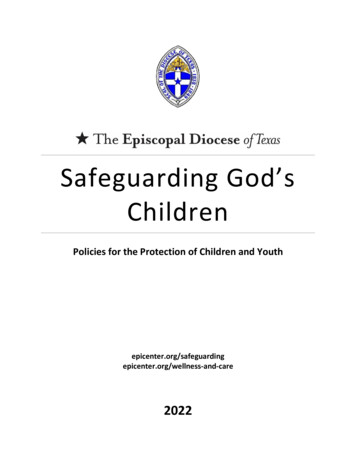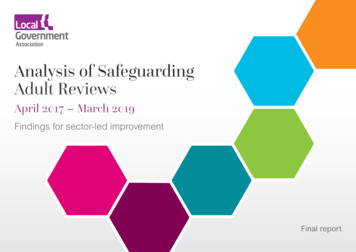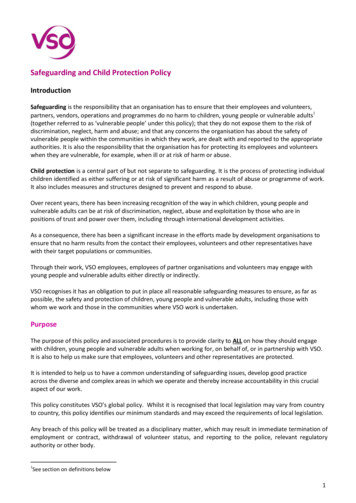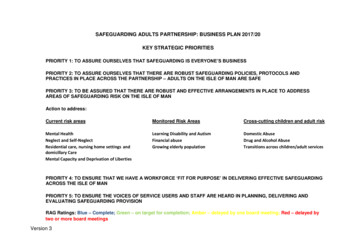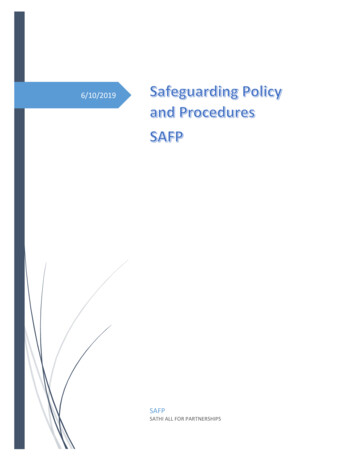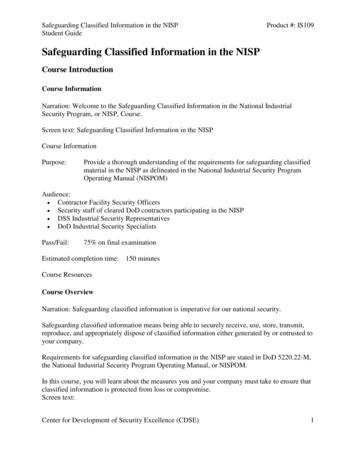
Transcription
Safeguarding Classified Information in the NISPStudent GuideProduct #: IS109Safeguarding Classified Information in the NISPCourse IntroductionCourse InformationNarration: Welcome to the Safeguarding Classified Information in the National IndustrialSecurity Program, or NISP, Course.Screen text: Safeguarding Classified Information in the NISPCourse InformationPurpose:Provide a thorough understanding of the requirements for safeguarding classifiedmaterial in the NISP as delineated in the National Industrial Security ProgramOperating Manual (NISPOM)Audience: Contractor Facility Security Officers Security staff of cleared DoD contractors participating in the NISP DSS Industrial Security Representatives DoD Industrial Security SpecialistsPass/Fail:75% on final examinationEstimated completion time: 150 minutesCourse ResourcesCourse OverviewNarration: Safeguarding classified information is imperative for our national security.Safeguarding classified information means being able to securely receive, use, store, transmit,reproduce, and appropriately dispose of classified information either generated by or entrusted toyour company.Requirements for safeguarding classified information in the NISP are stated in DoD 5220.22-M,the National Industrial Security Program Operating Manual, or NISPOM.In this course, you will learn about the measures you and your company must take to ensure thatclassified information is protected from loss or compromise.Screen text:Center for Development of Security Excellence (CDSE)1
Safeguarding Classified Information in the NISPStudent GuideProduct #: IS109Safeguard classified information when: Receiving Using Storing Transmitting Reproducing DisposingFor more information see NISPOM Chapter 5: Safeguarding Classified InformationCourse ObjectivesScreen text:Course Objectives: Identify the general requirements for safeguarding classified information Identify the requirements for control and accountability of classified information Identify options and requirements for storage of classified information Identify requirements for disclosure of classified information Identify requirements for reproduction of classified information Identify requirements for disposition of classified informationCourse StructureScreen text:Lessons Course Introduction Basic Concepts Obtaining Classified Information Storing Classified Information Using Classified Information Reproducing Classified Information Disposition of Classified Information Practical Exercise Course ConclusionCenter for Development of Security Excellence (CDSE)2
Safeguarding Classified Information in the NISPStudent GuideProduct #: IS109Basic ConceptsLesson IntroductionNarration: Before you learn about the various measures for safeguarding classified information,there are some concepts related to safeguarding that you should know. This lesson willfamiliarize you with these concepts.Screen text: Basic ConceptsLesson Objectives: Distinguish between the different types of classified information Identify the disclosure requirements for classified information Identify the information management requirements for classified informationClassification LevelsNarration: Classified information is categorized into three classification levels, Confidential,Secret, and Top Secret.Classification levels are applied to national security information that, if subject to unauthorizeddisclosure, could reasonably be expected to cause damage, serious damage, or exceptionallygrave damage to national security.Each classification level has its own requirements for safeguarding. The higher the level ofclassification, the more protection the classified information requires to reasonably prevent thepossibility of its loss or compromise.Screen text:Classified Information: Levels of classification:o CONFIDENTIALo SECRETo TOP SECRET Specific safeguarding requirements for each level Higher classification levels require more protectionCONFIDENTIAL rollover text: The classification level applied to information, theunauthorized disclosure of which reasonably could be expected to cause damage to thenational security that the original classification authority is able to identify or describe.SECRET rollover text: The classification level applied to information, the unauthorizeddisclosure of which reasonably could be expected to cause serious damage to the nationalsecurity that the original classification authority is able to identify or describe.Center for Development of Security Excellence (CDSE)3
Safeguarding Classified Information in the NISPStudent GuideProduct #: IS109TOP SECRET rollover text: The classification level applied to information, theunauthorized disclosure of which reasonably could be expected to cause exceptionallygrave damage to the national security that the original classification authority is able toidentify or describe.Forms of Classified InformationNarration: All forms of classified information must be protected. Forms of classified informationinclude classified finished or final documents, both paper-based and electronic, classifiedworking papers, classified waste, and classification-pending material.Classified working papers are documents that are generated in the preparation of a finisheddocument.Classified waste is classified information that is no longer needed and is pending destruction.Classification-pending documents are documents that require a classification determination fromthe Government Contracting Activity, or GCA. These documents must be safeguarded inaccordance with the proposed highest classification level until guidance is received from theGCA.Throughout this course you will learn the safeguarding requirements for each of these types ofclassified information.Screen text: You must safeguard all forms of classified information!Classified DocumentsWorking PapersClassified WasteClassification-Pending DocumentsElectronic Documents and MediaDisclosure to Authorized PersonsNarration: You must ensure that classified information is disclosed only to authorized persons.An authorized person is someone who has a need-to-know for classified information in theperformance of official duties and who has been granted a personnel clearance at the requiredlevel.So you are only authorized to disclose classified information to your cleared employees, toanother cleared contractor or sub-contractor, to a cleared parent company or subsidiary, within amultiple facility organization, or MFO, to DoD activities, or to Federal agencies when theiraccess is necessary for the performance of tasks or services essential to the fulfillment of aclassified contract, prime contract, or subcontract.Center for Development of Security Excellence (CDSE)4
Safeguarding Classified Information in the NISPStudent GuideProduct #: IS109Note that disclosure of classified information may be done in oral form. This will be discussedlater in the course.Screen text:Disclose classified information to: Authorized persons who have:o Need-to-knowo Personnel clearance (PCL) Authorized persons who are:o Cleared employeeso Cleared contractorso Cleared sub-contractorso Cleared parents or subsidiaries Cleared facilities of a multiple facility organization (MFO) DoD activities Federal agencies Fulfill the requirements of a:o Classified contracto Prime contracto SubcontractAuthorized persons rollover text: A person who has a need-to-know for classifiedinformation in the performance of official duties and who has been granted a personnelclearance (PCL) at the required level.Classified contract rollover text: Any contract requiring access to classified informationby a contractor or his or her employees in the performance of the contract. A contractmay be a classified contract even though the contract document is not classified. Therequirements prescribed for a “classified contract” also are applicable to all phases of thepre-contract activity.Cleared contractor’s rollover text: To become a cleared contractor, a company mustobtain a Facility Clearance (FCL) which is an administrative determination that, from asecurity viewpoint, a company is eligible for access to classified information of a certaincategory (and all lower categories).Multiple facility organization rollover text: A multiple facility organization (MFO) is alegal entity (single proprietorship, partnership, association, trust, or corporation)composed of two or more contractor facilities.Personnel clearance (PCL) rollover text: A personnel clearance (PCL) is anadministrative determination that an individual is eligible, from a security point of view,for access to classified information of the same or lower category as the level of theCenter for Development of Security Excellence (CDSE)5
Safeguarding Classified Information in the NISPStudent GuideProduct #: IS109personnel clearance being granted. Note: Eligibility plus access are considered to beequivalent to a personnel clearance.Prime contract rollover text: A contract let by a Government Contracting Activity (GCA)to a contractor for a legitimate government purpose.Subcontract rollover text: Any contract entered into by a contractor to furnish supplies orservices for performance of a prime contract or a subcontract. A subcontract is anycontract, subcontract, purchase order, lease agreement, service agreement, request forquotation (RFQ), request for proposal (RFP), invitation for bid (IFB), or other agreementor procurement action between contractors that requires or will require access toclassified information to fulfill the performance requirements of a prime contract.When Authorization is RequiredNarration: Before disclosing classified information to another DoD activity, Federal agency,foreign person, attorney, or Federal or state courts, you must have authorization from the DoDactivity or Federal agency that has classification jurisdiction over the information in question.Finally, classified information must never be disclosed to the public, and unclassifiedinformation about classified contracts may only be released to the public in accordance with theNISPOM. Although it is no longer classified, declassified information may not be disclosed tothe public unless approved in the same manner as classified information.Screen text:Before disclosing classified information in certain cases:To: A DoD activityA federal agencyA foreign personAn attorneyFederal or state courtsThe publicAuthorization is required: From the DoD activity or Federalagency that has classificationjurisdiction over the information As outlined in the NISPOMAlso applies to declassifiedinformationFor further information, see NISPOM 5-511: Disclosure to the PublicCenter for Development of Security Excellence (CDSE)6
Safeguarding Classified Information in the NISPStudent GuideProduct #: IS109Information Management SystemNarration: Contractors are required to establish an information management system to protectand control the classified information in their possession. The purpose of this requirement is toensure that you have the capability to retrieve classified information when it is necessary and toensure the appropriate disposition of classified information in a reasonable period of time.The information management system may be in the form of an electronic database or as simpleas a spreadsheet or log. You merely have to demonstrate capability for timely retrieval ofclassified information within the company and the capability to dispose of any and all classifiedinformation in the facility’s possession when required to do so.Screen text:Information management system: Protect and control classified informationo Retrieve informationo Ensure disposition No specific format requiredo Electronic databaseo Spreadsheeto Log Timely retrieval and disposal of classified information is requiredTop Secret AccountabilityNarration: Access and accountability records must be kept at various points in the Top Secretinformation lifecycle.When Top Secret information is produced by a contractor, a record must be kept indicating whenthe finished document was completed, when the information is retained for more than 180 daysregardless of its stage of development, or when it is transmitted inside or outside the facility.For more information about transmitting outside the facility, refer to the Transmission andTransportation for Industry e-Learning course offered by the Center for Development of SecurityExcellence, or CDSE.Each TOP SECRET item must be numbered in a series and the copy number must be placed onTOP SECRET documents and all associated transaction documents. Top Secret control officialsmust be designated to receive, transmit, and maintain access and accountability records for TopSecret information. An inventory must be conducted annually unless a written exception isobtained from the GCA.Screen text:Center for Development of Security Excellence (CDSE)7
Safeguarding Classified Information in the NISPStudent GuideProduct #: IS109Records must be kept for TOP SECRET information produced by a contractor when: Finished document is completed Information is retained for more than 180 days Information is transmitted inside or outside the facilityOther requirements: Top Secret control officials must be designated to receive, transmit, and maintain accessand accountability records Conduct annual inventory unless a written exception is obtained from the GCACallout text: Transmission and Transportation for Industry Course (IS107.16)Review Activity 1Screen text:All classified information should be afforded the same level of protection regardless of theclassification level of the information.o Trueo FalseClassified waste must be safeguarded until it is destroyed.o Trueo FalseContractors are required to establish an information management system to protect and controlclassified information in their possession.o Trueo FalseAll classified information must be numbered in a series.o Trueo FalseAnswer Key:All classified information should be afforded the same level of protection regardless of theclassification level of the information.o True FalseClassified waste must be safeguarded until it is destroyed. Trueo FalseContractors are required to establish an information management system to protect and controlclassified information in their possession.Center for Development of Security Excellence (CDSE)8
Safeguarding Classified Information in the NISPStudent GuideProduct #: IS109 Trueo FalseAll classified information must be numbered in a series.o True FalseReview Activity 2Screen text:Which of the following must a person have to be authorized to handle classified information? Classification jurisdiction Need-to-know Personnel clearance (PCL) Original classification authorityAnswer KeyWhich of the following must a person have to be authorized to handle classified information? Classification jurisdiction Need-to-know Personnel clearance (PCL) Original classification authorityLesson SummaryScreen text: You have completed “Basics Concepts.”Center for Development of Security Excellence (CDSE)9
Safeguarding Classified Information in the NISPStudent GuideProduct #: IS109Obtaining Classified InformationObjectivesNarration: Contractors can obtain classified information either by receiving it from thegovernment or another cleared contractor, or by generating it internally. In this lesson you willlearn about the guideline’s contractors must follow in obtaining classified information.Screen text: Obtaining Classified InformationLesson Objectives: Identify the contractor’s responsibilities and procedures in receiving classifiedinformation Identify the contractor’s responsibilities and procedures in generating classified orderivatively classifying informationClearance of Receiving IndividualNarration: Classified material coming into a facility must be received directly by authorizedpersonnel, whether it’s in the form of a package, envelope, fax, email, or phone call.An authorized person means a cleared person who has been assigned this duty and, therefore, hasa need-to-know. This means that the individual who picks up the mail or accepts deliveries fromthe U.S. Postal Service or commercial delivery companies approved for transmitting classifiedmaterial must be cleared to the level of the classified material expected to be received by thecontractor.All employees who are authorized to receive or sign for U.S. Registered or U.S. Express mailmust have Secret clearances. Likewise, employees who are authorized to receive or sign for U.S.Certified Mail must have CONFIDENTIAL clearances. If the person who normally acceptsdeliveries is not cleared, that individual must call the Facility Security Officer, or FSO, or othercleared person to sign for packages that require signatures.If no cleared employee is available, the uncleared person must refuse the package. This is trueeven if the uncleared person does not have any intention of ever opening the package. In the caseof delivery to a P.O. Box, an authorized person must go to the post office, unlock the post officebox, sign for its contents when a signature is required, and bring the classified informationdirectly back to the facility.For more information on authorized methods for transporting and transmitting classifiedinformation, refer to the Transmission and Transportation for Industry e-Learning course offeredby the Center for Development of Security Excellence, or CDSE.Screen text:Center for Development of Security Excellence (CDSE)10
Safeguarding Classified Information in the NISPStudent GuideProduct #: IS109Classified Information must be: Received directly by an authorized person who:o Has a need-to-knowo Is cleared to the level of the classified material Refused if an authorized person is not available to receive the package Picked up and signed for by an authorized person, if delivered to a P.O. BoxTo sign forpackages thatarrive via:Clearancerequired:U.S. Registered Mail SECRETU.S. Express MailU.S. Certified MailCONFIDENTIALHandling Upon ReceiptNarration: Once a Registered or Certified package has been received by an authorized person, heor she should examine the outer package for evidence of tampering. If the receiver suspectstampering, the Facility Security Officer, or FSO, should be immediately notified.The FSO or another cleared employee that the FSO has delegated the responsibility to performthese duties should first determine if the package contains classified information by inspectingthe inner package.If it does contain classified information and the inner package has been tampered with, then theFSO or designee must conduct an inquiry and determine whether a loss, compromise orsuspected compromise of classified information in accordance with the NISPOM had occurred.If a loss, compromise or suspected compromise has occurred, the FSO must notify both thesender and their Cognizant Security Office, or CSO.If the receiver does not suspect any tampering on the outer package, they must immediately turnthe package over to the designated document custodian, who may be the FSO or the FSO’sdesignee for processing. If the designated custodian is not able to open and process the packageat that time, it must be protected as if it were classified until it is opened and a classificationdetermination is made.When the designated custodian opens and processes the package, the inner package should alsobe inspected for evidence of tampering.If tampering is detected, the FSO or designee must conduct an inquiry and determine whether aloss, compromise or suspected compromise of classified information in accordance with theNISPOM had occurred. If a loss, compromise or suspected compromise has occurred, the FSOmust notify both the sender and their CSO.Center for Development of Security Excellence (CDSE)11
Safeguarding Classified Information in the NISPStudent GuideProduct #: IS109Next the designated custodian incorporates the material into the facility’s informationmanagement system, or IMS, and checks the contents of the package against the receipt. If thereis a discrepancy, or if there is no receipt in a TOP SECRET or SECRET package, the sendermust be contacted immediately. Receipts are not required for CONFIDENTIAL packages butmay be included at the sender's discretion. If the package contents match the receipt, thedesignated custodian signs and returns it to the sender.Next, the designated custodian verifies through the current DoD system of record or the facility’srecords that the intended recipient has the appropriate clearance level and verifies the intendedrecipient’s need-to-know. This may be done by contacting the recipient’s supervisor or projectmanager. In many cases this determination will be made by the FSO who is aware of whatprojects each cleared employee is working on.After verification of these items, the designated custodian notifies the intended recipient that thematerial has arrived and arranges for that person to access the information. If the designatedcustodian cannot verify the intended recipient’s clearance level or need-to-know, he or sheshould contact the cleared project manager for that contract to determine who should receive theclassified material.Screen text:CSO rollover text:Cognizant Security OfficeDISS rollover text:Defense Information System for Security (successor toJoint Personnel Adjudication System or JPAS)FSO rollover text:Facility Security OfficerCenter for Development of Security Excellence (CDSE)12
Safeguarding Classified Information in the NISPStudent GuideProduct #: IS109IMS rollover text:Information Management SystemJPAS rollover text:Joint Personnel Adjudication SystemN-T-K rollover text:Need-to-knowtampering rollover text:Tampering is a deliberate attempt to gain illegal orunauthorized access to the contents of a shipment.TS/S rollover text:Top Secret/SecretFrom Commercial CarriersNarration: When a shipment is received via a cleared commercial carrier, usually a truckingfirm, the sender notifies the recipient in advance as to when the shipment is to be expected. If theshipment is not received within 48 hours after the expected time of arrival, the recipient mustcontact the sender immediately.For more detailed information, refer to the Transmission and Transportation for Industry eLearning course offered by CDSE.Screen text:When packages are received via cleared commercial carriers: Sender notifies recipient of expected arrival date Recipient notifies sender if package not received within 48 hours of expected dateDerivatively Classified MaterialNarration: In addition to receiving classified information from outside sources, contractors mayproduce classified information internally. This process of generating new classified materialsfrom already existing classified information is known as derivative classification.For more information about the process, refer to the Derivative Classification e-Learning courseoffered by CDSE.Contractors are required to properly safeguard any classified materials they generate, orderivatively classify, and implement an IMS which is capable of facilitating the retrieval anddisposition of their classified holdings in a timely manner. Depending on the type of information,additional requirements may apply.The NISPOM requires contractors to keep a formal record of any Top Secret material theyreceive or generate at their company. Contractors must follow guidance from the Central OfficeCenter for Development of Security Excellence (CDSE)13
Safeguarding Classified Information in the NISPStudent GuideProduct #: IS109of Record for entering any COMSEC material they generate into the accountability system. TheNISPOM also contains guidance about generating and marking NATO materials.Finally, contractors must properly mark all classified information they generate, or derivativelyclassify.For more information about properly marking classified information, refer to the MarkingClassified Information e-Learning course and the Marking in the Electronic Environment Shortoffered by CDSE.Screen text: Derivative ClassificationRequired procedures: Implement IMS to facilitate retrieval and disposition of classified holdings Apply any special requirements based on the type of information:o Create a record of any Top Secret material (NISPOM 5-203)o Follow COR guidance for COMSEC materialo Follow requirements for NATO documents (NISPOM 10-709) Mark generated classified information properlySelectable Button:MORECOMSEC rollover text:Communications SecurityCOR rollover text:Central Office of RecordDerivative Classification rollover text:Incorporating, paraphrasing, restating, orgenerating in new form information that isalready classified and marking the newlydeveloped material consistent with theclassification markings that apply to thesource.IMS rollover text:Information Management SystemNATO rollover text:North Atlantic Treaty OrganizationNISPOM rollover text:National Industrial Security Program Operating ManualMORE popup text:Derivative Classification is the incorporating, paraphrasing,restating, or generating in new form information that is alreadyclassified and marking the newly developed material consistentwith the classification markings that apply to the sourceinformation. Derivative classification includes the classification ofinformation based on classification guidance. The duplication orCenter for Development of Security Excellence (CDSE)14
Safeguarding Classified Information in the NISPStudent GuideProduct #: IS109reproduction of existing classified information is not derivativeclassification. Persons who apply derivative classificationmarkings shall observe and respect original classification decisionsand carry forward to any newly created documents any assignedauthorized markings.Working PapersNarration: The NISPOM also contains requirements that apply when a contractor createsclassified working papers in preparation of a finished document. The working papers must bedated when created, marked with their highest classification level and protected at that level,marked with the annotation “Working Papers,” and destroyed when they are no longer needed.Working papers must be marked in the same manner prescribed for a finished document at thesame classification level when it is transmitted outside the facility, filed permanently, emailedwithin or released outside the originating activity, or retained for more than 180 days from thedate of creation.Screen text:Required procedures: Date when created Mark with classification and “Working Papers” Destroy when not needed Mark in same manner as finished document when:o Transmitted outside the facilityo Filed permanentlyo Emailed within or released outside the originating activityo Retained for more than 180 daysDocument rollover text:Any recorded information, regardless of the natureof the medium or the method or circumstances ofrecording.Working Papers rollover text:Documents or materials, regardless of the media,which are expected to be revised prior to thepreparation of a finished product for disseminationor retention.For more information review NISPOM 5-203 b: Generation of Classified MaterialCenter for Development of Security Excellence (CDSE)15
Safeguarding Classified Information in the NISPStudent GuideProduct #: IS109Review Activity 1Screen text:A person may be authorized to receive and sign for classified information if they are cleared tothe level of the classified information they are receiving.o Trueo FalseOnly an authorized person may receive and sign for packages that may contain classifiedinformation.o Trueo FalseAll employees may pick up classified packages at a P.O. Box as long as they sign a form statingthey will not open the package.o Trueo FalseThe designated document custodian must contact the sender immediately if there is no receipt ina CONFIDENTIAL package.o Trueo FalseAnswer KeyA person may be authorized to receive and sign for classified information if they are cleared tothe level of the classified information they are receiving. Trueo FalseOnly an authorized person may receive and sign for packages that may contain classifiedinformation. Trueo FalseAll employees may pick up classified packages at a P.O. Box as long as they sign a form statingthey will not open the package.o True FalseThe designated document custodian must contact the sender immediately if there is no receipt ina CONFIDENTIAL package.o True FalseCenter for Development of Security Excellence (CDSE)16
Safeguarding Classified Information in the NISPStudent GuideProduct #: IS109Review Activity 2Screen text:Formal accountability records of material generated within a facility are required for whichclassification level?o TOP SECRETo SECRETo CONFIDENTIALAnswer KeyFormal accountability records of material generated within a facility are required for whichclassification level? TOP SECRETo SECRETo CONFIDENTIALLesson SummaryNarration: You have completed the Obtaining Classified Information lesson.Screen text: You have completed “Obtaining Classified Information.”Storing Classified InformationObjectivesNarration: In order to safely store classified information, there are various requirements that mustbe met, such as use of proper equipment and closed areas, locks, supplemental protection, andsafeguarding procedures.In this lesson, you will learn about the various requirements for the physical protection ofclassified material.Screen text: Storing Classified InformationLesson Objectives Identify types of and requirements for using storage equipment and closed areas Identify types of and procedures for using locking devices Identify types of and guidelines for using supplemental protection Identify the requirements for all possessing facilitiesCenter for Development of Security Excellence (CDSE)17
Safeguarding Classified Information in the NISPStudent GuideProduct #: IS109OverviewNarration: Storage of classified info
material in the NISP as delineated in the National Industrial Security Program Operating Manual (NISPOM) Audience: Contractor Facility Security Officers Security staff of cleared DoD contractors participating in the NISP DSS Industrial Security Representatives DoD Industrial Security Specialists . Pass/Fail: 75% on final examination


